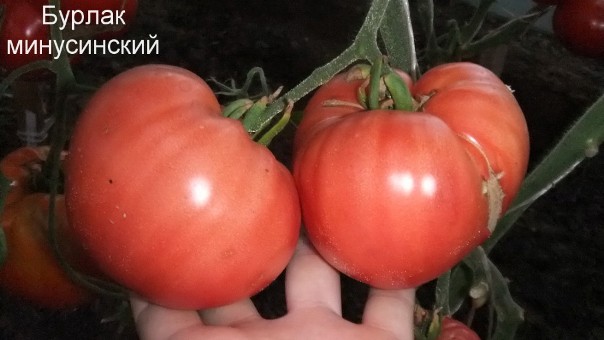 Legendary Minusinski tomatoes are the pride of Siberia and are known for their large size and excellent taste. Despite the fact that the collection of these tomatoes was not recorded by the register of selection achievements in the Russian Federation, all of them are very popular among vegetable growers.
Legendary Minusinski tomatoes are the pride of Siberia and are known for their large size and excellent taste. Despite the fact that the collection of these tomatoes was not recorded by the register of selection achievements in the Russian Federation, all of them are very popular among vegetable growers.
One of such favorites of folk selection is the early ripe, high-yielding variety "Burlak Minusinsky."
Content
Grade description
Of the entire collection of Minusinski tomatoes, "Burlak Minusinskiy" is the only one that has early ripening. Bred and tested in the conditions of the Krasnoyarsk Territory, where the average temperature in July is only 13 ° C, this variety is suitable for any region of the country. Due to the fact that the tomato is included in the group of determinants, it is recommended to grow it in greenhouse conditions. Of course, this does not apply to the southern regions, where even without cover he will be able to bear fruit for a rather long period.
The variety is characterized by unlimited growth and tomatoes in height often exceed the mark of 2 meters. Creeper plants have a powerful root system that goes deep into the ground. The leafiness of the bushes is medium, the leaf plate is not wide, dark green in color and has a potato type. Stepsons are actively formed throughout the growing season.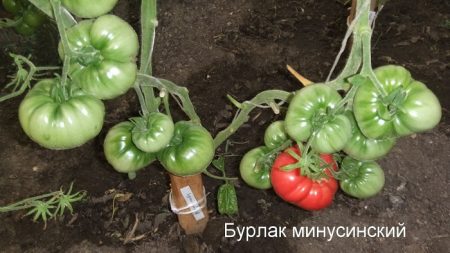
Fruits of a beautiful flat-rounded shape with "ribbed shoulders" near the stem. Tomatoes of appetizing raspberry color without a green spot at the base are in full maturity. Such handsome men ripen fairly large in size from three hundred to six hundred grams. The fruits of this variety are famous for their exquisite taste and fleshy, delicate, sugary crushed flesh. A balanced amount of sugars and acids makes the taste of the tomato unforgettable, and the thin and dense skin does not allow them to crack. Such tomatoes are ideal for fresh consumption, the preparation of juices and pastes.
Productivity of the variety, subject to proper agricultural practices, is about 5 kg per bush. According to the experience of experienced summer residents, the best yield indicators are observed when planting in two stems.
Agricultural technology
How to calculate the timing of sowing seeds
The date of sowing seeds of this variety must be planned in such a way that by the time of planting of tomatoes in a constant place, its age was 60-65 days from germination. It should be remembered that seed germination also takes time, usually 5-7 days.
To determine the time from which sowing time should be counted, it is important to take into account the characteristics of your region and future planting conditions (a heated or unheated greenhouse, open ground).
It should be borne in mind that tomato is a southern and thermophilic crop. And despite the endurance of the variety, subzero temperatures will lead to the death of plants. In the warm southern regions of Russia, the time for planting in the greenhouse falls on April 15-May 1. In the middle lane, the optimal time for transplant work will be the period from May 1 to May 15. But the main reference point for any part of Russia is still air temperature, it should not be lower than 15 degrees during the day and below 10 degrees at night.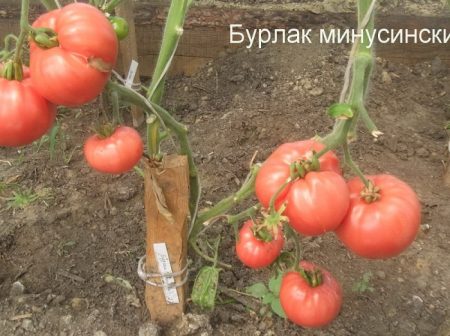
How to care for seedlings
The appearance of the first green loops on the soil surface means that the germination stage was successful, and it is time to create a microclimate suitable for further normal growth. Tanks with seedlings are installed on the brightest place in the room or provide artificial lighting with phytolamps. The air temperature is optimal for seed germination and for a person to live comfortably is no longer suitable for seedlings. It is necessary to reduce the temperature to 15-16 ° C as soon as possible after germination. Under this regime, young plants will grow for another 2-3 weeks. If this is not done, the seedlings will turn into thin long stems with an undeveloped root system. Reduced temperature, on the contrary, does not promote the growth of the terrestrial part of the plant, but the underground, that is, the roots. At the same time, the first pair of leaves is formed without delay, and the seedling remains strong and stocky.
After 2-3 weeks, when the seedlings grow up, get stronger and will have 2-3 real leaves, they pick. After transplanting tomatoes in separate containers, the temperature regime is again changed. Now, for normal growth until the moment of transplantation to a permanent place, plants need an air temperature in the region of 18-20 ° C.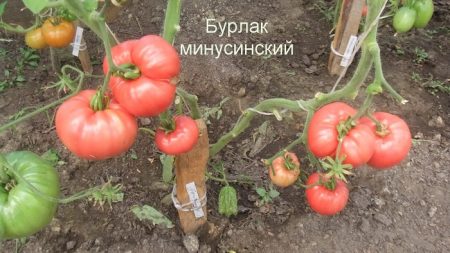
Further care consists in moderate irrigation with warm water and top dressing if necessary. It is possible to determine whether plants have enough nutrients by the appearance of seedlings.
- So, if the leaves turn pale before the eyes, and the veins are clearly manifested, it means that there is a deficiency of iron. In this case, the bushes are sprayed with a solution of iron sulfate.
- If, with regular watering and good lighting, the plants have a stunted appearance, and the leaves begin to turn yellow, this indicates a lack of nitrogen in the soil. In this case, the leaves of the seedlings are sprayed with a urea solution.
- Darkening of the leaves and the presence of a purple hue on their underside is a sure sign of a lack of phosphorus. In this case, root top dressing with superphosphate will come to the rescue.
- The fragility of seedlings and signs of curling leaves indicate a lack of magnesium. So it's time to feed the seedlings with a solution of magnesium sulfate.
How to plant in the ground
The characteristic of this variety does not allow compacted plantings. To obtain good results, it is necessary to strictly follow the recommended scheme and plant no more than four seedlings per square meter in the case of formation in one stem and no more than three - in the formation of two stems. More frequent planting is not recommended due to the powerful root system of plants, as this leads to a reduction in the nutrition area of each seedling and, as a consequence, a decrease in yield.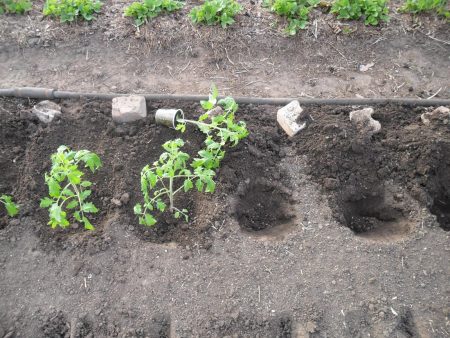
How to care for tomatoes after transplanting
The main features of tomato care “Burlak Minusinskiy” after transplantation are:
- Stepsoning and shaping
The stepsoning procedure is mandatory and the most time-consuming. It must be carried out in a greenhouse throughout the growing season, not allowing stepsons to outgrow. In the process of removing side shoots, a bush forms. Plants of this variety are formed into one or two main trunks. If the recommendations are not followed, the gas exchange is disturbed, the moisture balance is disturbed, and there is a shortage of light and oxygen.
- Tying
This procedure is no less mandatory for plants. Tall tomatoes need support pylons. It can be high and stable stakes, wooden trellises or an agri-grid. Tie bushes immediately from the moment of transplantation and continue to do this all season as they grow. Materials for this should be strong, but soft, so as not to damage parts of the plants, as well as necessarily disinfected or new.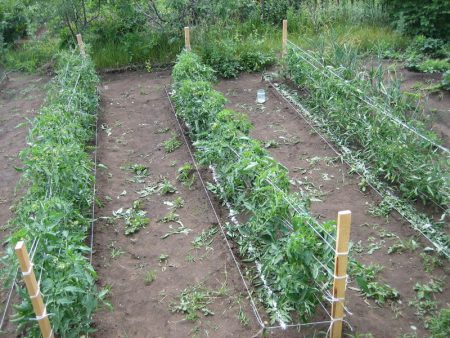
- Lightening
Lightening is the regulation of the vegetative mass of tomatoes. First, the lower leaves of the seedlings are removed. The time when you need to do this will tell you the appearance, the leaves will turn yellow and fade.Throughout the growing season, the leaves should be removed and under each fruit brush, after the fruits are tied to them. This reduces the load on the plant, improves ventilation and light access.
- Watering
In plants of this variety, the main roots go deep into the soil and a large number of roots are located near the surface of the earth, respectively, and watering should be rare, but plentiful. It is important to ensure that the water jet does not erode the soil around the trunk of the plant. The water temperature should not be lower than 22 ° C.
- Mulching
Mulch the soil under the bushes immediately after transplanting them into a greenhouse or soil. As mulch, straw, mowed grass, newspapers, cardboard are suitable. This agricultural technique keeps the topsoil from drying out and from the growth of weeds.
- Turning
Pinching the crown of the stem is carried out a month before the onset of stable cold. At the same time, 3-4 leaves are left over the last fruit brush. This procedure allows all ripened fruit to ripen.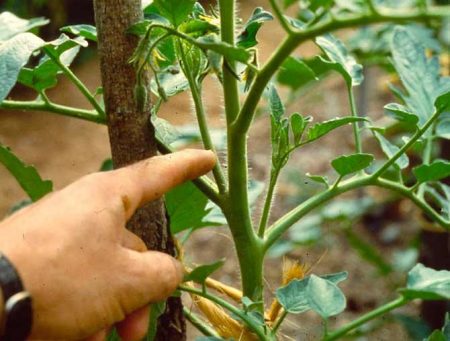
Harvesting Tomatoes
The fruits in the greenhouse are reliably protected from sudden changes in temperature and cold growth, so there is no urgent need to take the entire crop at the stage of milk maturity for ripening at home. You can do this little by little in order to stimulate the formation of new ovaries. As autumn approaches, fruits that are already set can be left to sing on the bush if the air temperature does not drop below 8 ° C.
It is enough to take tomatoes at the beginning of fruiting once every five days, at the height of the season every two to three days, it is better in the morning. If you still collect the fruits for ripening at home, they are placed in baskets or boxes lined with natural fabric inside. To accelerate ripening, a couple of ripe ones are added to unripe fruits. They will produce ethylene and significantly reduce the ripening time.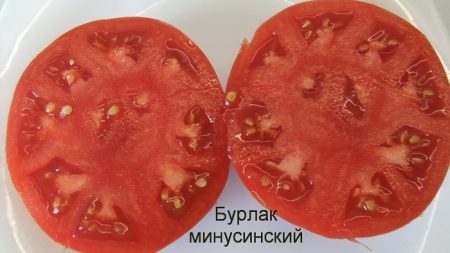
Diseases and Pests
A tomato of this variety is not resistant enough to the main nightshade disease - late blight. Therefore, to prevent the spread of this fungus, regular preventative treatments should be carried out. Well, drugs containing copper or sulfur help in this.
Advantages and disadvantages
The positive features of the variety include: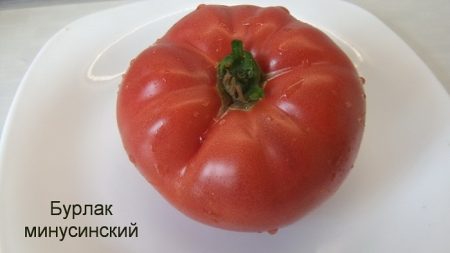
- early ripening;
- long fruiting period (under good conditions until late autumn);
- tall bushes (allows full use of the space of greenhouses);
- large-fruited;
- excellent taste;
- interesting form of tomatoes;
- good yield;
Among the disadvantages, the following can be distinguished:
- ribbing of fruits;
- prolonged fruiting is only possible in a greenhouse;
- requires pinching and tying throughout the season;
- afraid of late blight.
Tomato "Burlak Minusinskiy" can not be called unpretentious variety. To obtain a good harvest, certain growing conditions and proper care are required. But all this is more than paid for by the exquisite taste of the fruit. Therefore, summer residents, sparing neither energy nor time, annually continue to plant this variety in their plots.
Reviews
Ekaterina Vasilievna, Chelyabinsk Region
I got the seeds directly from Minusinsk. Luckily, after a few hands, from a woman friend. Two of my precious bushes grew in the greenhouse, the plants are very tall and powerful. She led both equally, in two stems. It is a pleasure to take care of such tomatoes, especially when you see such tomatoes on a bush. In one hand, 2-3 fruits, two very large, the third is much smaller.Taste is just an overeating, a pulp like a watermelon. Naturally collected seeds and of course I will plant more.
Olga, Nizhny Novgorod Region
Wonderful variety! I am delighted! Of course, stepsons form a lot and you need to tie it up, as they say on conscience, but the result is ... chic! In July, sugar tomatoes from the greenhouse were already eaten. One tomato and the whole family well-fed and happy. I have such a first grade, so that it is both early and large-fruited, and even so tasty, and not watery, as often happens.
Anna, Buturlinovka, Voronezh region
A good crop was harvested without a greenhouse. Of course, I didn’t let them grow very tall bushes, just in case I nipped them early, I wanted the first 2-3 brushes to ripen right on the vine. I did it. By weight, the first 400 g came out, then a little smaller. The taste of course pleased and the "ribs" are so unusual in tomatoes. I’ll plant it myself and recommend it to everyone to try. Especially for those who have good greenhouses.




 Low-growing tomatoes, without pinching: 5 of the most delicious varieties
Low-growing tomatoes, without pinching: 5 of the most delicious varieties Why tomato seedlings grow poorly
Why tomato seedlings grow poorly We grow a tomato in a shell
We grow a tomato in a shell Growing tomatoes without watering according to the method of Kazarin
Growing tomatoes without watering according to the method of Kazarin